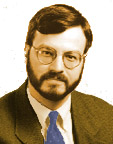|
|
Jacob Sullum
"PASSIVE SMOKING Smoking Doesn't Cause Cancer," announced the headline of a recent story in
the London Telegraph that described a study by the World Health Organization.
"Passive Smoking Does Cause Lung Cancer," said the headline of a WHO press
release issued the next day.
The contradictory headlines had something in common: Both went beyond what the
evidence shows. Indeed, since any lung cancer risk from environmental tobacco smoke
(ETS) is likely to be minuscule, we may never be able to verify an effect -- or rule one
out -- using the crude tools of epidemiology.
The WHO study,
But they calculated that subjects married to smokers were 1.16 times as likely to have
lung cancer as those married to nonsmokers. The risk was slightly higher (1.17) for
subjects who worked with smokers and slightly lower (1.14) for those who had both
kinds of exposure.
If the study really had measured risk with the precision implied by these numbers, it
would be odd that people with greater exposure were less likely
to have lung cancer. But given the statistical margins of error, these three risk ratios
are indistinguishable. More important, each of them is indistinguishable from a ratio of
1.0, meaning no added risk -- another way of saying that the results are statistically
insignificant.
British-American Tobacco said the study -- which has not yet been published by a
medical journal but was summarized in a report from WHO's International Agency for
Research on Cancer -- indicated that "the risk of lung cancer from environmental
tobacco smoke (is) either non-existent or too small to be measured at any meaningful
level." WHO insisted that "the findings were consistent with earlier studies."
Both were right. Weak, statistically insignificant associations are typical of the research
on ETS and lung cancer. This is the pattern you'd expect if ETS had a barely
detectable effect.
It is also the pattern you'd expect if ETS had no effect but other factors, such as
dietary habits or unreported smoking, were boosting lung cancer rates among the
subjects classified as exposed. Researchers try to take such factors into account, but
since they are forced to rely largely on self-reports, it's impossible to know whether
their adjustments are adequate.
The impact of ETS is difficult to assess mainly because the doses of carcinogens
absorbed by nonsmokers are tiny compared to those absorbed by smokers, so any
risk would be correspondingly small. The problem is complicated by the fact that lung
cancer is rare among nonsmokers, making it hard to get samples big enough to
generate statistically significant results.
Consequently, there is plenty of room for spin. Gordon McVie, director of Britain's
Cancer Research Campaign, said BAT's take on the WHO study was "highly
misleading." Yet, his own summary of the evidence indicates that the case against ETS
is not exactly overwhelming: "The weight of the statistics show that there is more likely
to be an effect than not to be an effect. The risk is a small one, but the evidence
certainly does not prove that no risk is present."
That measured assessment contrasts sharply with the assertions of American
anti-smoking activists and public health officials, who say there's no doubt that ETS
poses a dire threat and darkly imply that anyone who disagrees must be allied with the
tobacco companies. Longtime anti-smoker Stanton Glantz tars skeptics as "apologists"
who are "repeating the standard industry arguments."
Such blithe dismissals avoid the need to deal with criticism. They also suggest that only
the skeptics have an agenda, when in fact tobacco's opponents are heavily invested in
the idea that ETS kills. As Glantz noted in 1986, that claim allows anti-smokers to use
"the rhetoric of the environment, toxic chemicals and public health rather than the
rhetoric of saving smokers from themselves."
In a 1997 Washington Post story on ETS, the widely respected University of Chicago
biostatistician John C. Bailar said "the evidence for lung cancer is not as strong as
some of the proponents say (it) is. That is not to say that they are wrong but that they
might be wrong." It's a possibility that people like Glantz seem never to
 A whiff of risk
A whiff of risk
 the second largest of its kind, included 650 nonsmokers with lung
cancer and 1,542 controls. After dividing the subjects into groups based on reported
contact with smokers, the researchers found "there was no association between lung
cancer risk and ETS exposure during childhood."
the second largest of its kind, included 650 nonsmokers with lung
cancer and 1,542 controls. After dividing the subjects into groups based on reported
contact with smokers, the researchers found "there was no association between lung
cancer risk and ETS exposure during childhood."
03/12/98: BAC Scratching
03/5/98: Felonious Speech
02/20/98: Rules of the game
02/13/98: Feeling his pain... and a little pleasure